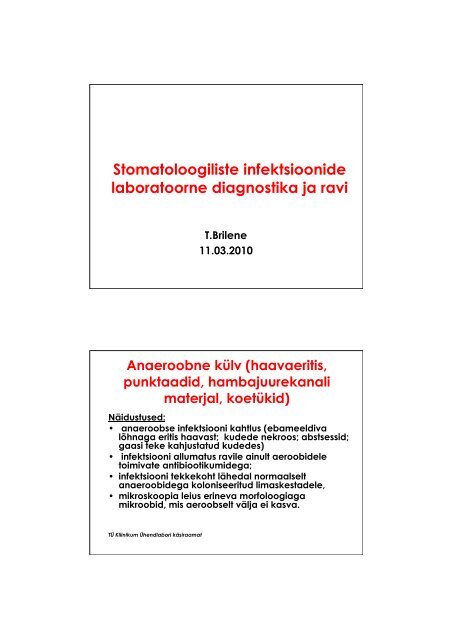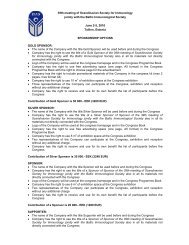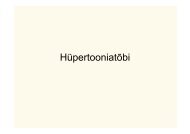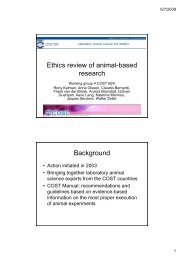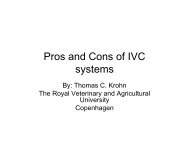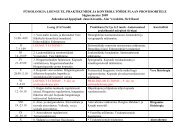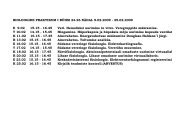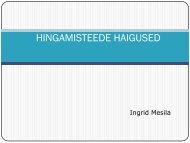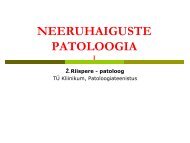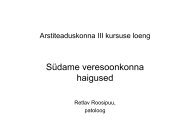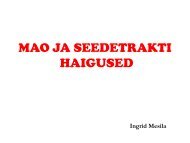Stom infektsioonide lab diagnostika ja ravi.pdf
Stom infektsioonide lab diagnostika ja ravi.pdf
Stom infektsioonide lab diagnostika ja ravi.pdf
You also want an ePaper? Increase the reach of your titles
YUMPU automatically turns print PDFs into web optimized ePapers that Google loves.
<strong>Stom</strong>atoloogiliste <strong>infektsioonide</strong><br />
<strong>lab</strong>oratoorne <strong>diagnostika</strong> <strong>ja</strong> <strong>ravi</strong><br />
T.Brilene<br />
11.03.2010<br />
Anaeroobne k¸lv (haavaeritis,<br />
punktaadid, hambajuurekanali<br />
mater<strong>ja</strong>l, koet¸kid)<br />
N‰idustused:<br />
ï anaeroobse infektsiooni kahtlus (ebameeldiva<br />
lıhnaga eritis haavast; kudede nekroos; abstsessid;<br />
gaasi teke kahjustatud kudedes)<br />
ï infektsiooni allumatus <strong>ravi</strong>le ainult aeroobidele<br />
toimivate antibiootikumidega;<br />
ï infektsiooni tekkekoht l‰hedal normaalselt<br />
anaeroobidega koloniseeritud limaskestadele,<br />
ï mikroskoopia leius erineva morfoloogiaga<br />
mikroobid, mis aeroobselt v‰l<strong>ja</strong> ei kasva.<br />
T‹ Kliinikum ‹hend<strong>lab</strong>ori k‰siraamat
Abstsessid, punktaadid:<br />
ï desinfitseerida punktsioonikoha nahk.<br />
ï Punkteerida, aspireerida mater<strong>ja</strong>l s¸stlasse.<br />
ï Kui abstsessi punkteerimisel on m‰daeritus v‰hene,<br />
s¸stida sinna steriilset f¸sioloogilist lahust ning<br />
aspireerida see tagasi s¸stlasse.<br />
ï Eemaldada katsutilt kork, s¸stida mater<strong>ja</strong>l<br />
katsutisse.<br />
ï Mida suurem on mater<strong>ja</strong>li hulk, seda suurem on<br />
anaeroobide s‰ilimise <strong>ja</strong> isoleerimise tıen‰osus.<br />
T‹ Kliinikum ‹hend<strong>lab</strong>ori k‰siraamat<br />
M‰da, haavaeritis:<br />
ï haava pind puhastada steriilse f¸sioloogilise<br />
lahusega, eemaldada nekrotiseerunud kude<br />
(sisaldab leukots¸¸tide poolt juba surmatud<br />
mikroobe <strong>ja</strong> detriiti).<br />
ï Parimaks mater<strong>ja</strong>liks haavast on s¸stlaga<br />
aspireeritud m‰da vıi koet¸kid.<br />
ï Kui nimetatud mater<strong>ja</strong>li pole vıimalik saada, vıtta<br />
proov tampooniga haavast vıimalikult s¸gavalt.<br />
ï Suruda tampoon katsutisse nii, et vatiosa ulatuks<br />
sˆˆtmesse.<br />
T‹ Kliinikum ‹hend<strong>lab</strong>ori k‰siraamat
ï Hambajuurekanali m‰da: sondi abil vıtta mater<strong>ja</strong>l<br />
juurekanalist vıimalikult s¸gavalt, suruda sond<br />
otsapidi transportsˆˆtmesse.<br />
ï Koet¸kid: suruda steriilsete pintsettidega<br />
transportsˆˆtmesse.<br />
ï NB! Anaeroobsete tingimuste s‰ilitamiseks hoida<br />
katsutit kogu aeg vertikaalasendis, et CO2, mis on<br />
ıhust raskem, ei voolaks katsutist v‰l<strong>ja</strong>.<br />
ï S‰ilitamine <strong>ja</strong> transport: toatemperatuuril (+20-25 C)<br />
¸ks ˆˆp‰ev.<br />
T‹ Kliinikum ‹hend<strong>lab</strong>ori k‰siraamat<br />
ï Anal¸¸simeetod: k¸lv Wilkins-Chalgreni agarile <strong>ja</strong><br />
selektiivsele Wilkins-Chalgreni agarile.<br />
ï Kultiveerimine anaeroobses keskkonnas.<br />
ï Tekita<strong>ja</strong> isoleerimine, samastamine <strong>ja</strong><br />
<strong>ravi</strong>mtundlikkuse m‰‰ramine.<br />
ï Lıplik vastus: negatiivne 5.-6. p‰eval, positiivne<br />
koos tundlikkusega 7. p‰eval (Actinomyces spp.<br />
korral kuni 2 n‰dalat).<br />
ï Vıimalikud vead: proovi vıtmine antibakteriaalse<br />
<strong>ravi</strong> foonil, vead s‰ilitamisel <strong>ja</strong> transpordil.<br />
T‹ Kliinikum ‹hend<strong>lab</strong>ori k‰siraamat
Transportsˆˆde<br />
Parodontiidi mikrobioloogiline<br />
<strong>diagnostika</strong><br />
N‰idustused: parodontiit, <strong>ravi</strong>le allumatu parodontiit<br />
ï Proovide vıtmine<br />
ï Eelneb lokaalanesteesias mehaaniline biokile<br />
eemaldamine ning juurepindade silestamine ¸le<br />
kogu hammaskonna.<br />
ï Igemetasku kaabe vıetakse kuuest s¸gavamast<br />
igemetaskust hambapindadelt steriilse k¸retiga <strong>ja</strong><br />
kantakse <strong>lab</strong>oris valmistatud anaeroobsesse<br />
transportsˆˆtmesse<br />
ï S‰ilitamine <strong>ja</strong> transport: toatemperatuuril<br />
(anaeroobid), mater<strong>ja</strong>l peab <strong>lab</strong>orisse jıudma<br />
proovi vıtmise p‰eval.<br />
T‹ Kliinikum ‹hend<strong>lab</strong>ori k‰siraamat
Metoodika<br />
ï Esmask¸lvid<br />
ï Transportsˆˆtmest tehakse 5 j‰rjestikust lahjendust <strong>ja</strong><br />
k¸lvatakse Brucella agarile ning<br />
ï A. actinomycetemcomitansíi isoleerimiseks TSBV<br />
Tryptic Soy Serum Bacitracin Vancomycin Agar<br />
ï Lıplik vastus: 7.-10. p‰eval.<br />
ï Tılgendus<br />
ï Parodontiidi tekita<strong>ja</strong>te samastamine<br />
(A. actinomycetemcomitans, Porphyromonas<br />
gingivalis, Bacteroides forsythus, Fusobacterium<br />
nucleatum, Prevotella intermedia/nigrescensíi grupp,<br />
Peptostreptococcus micros, Campylobacter rectus,<br />
enterokokid <strong>ja</strong> enterobakterid) <strong>ja</strong> patogeeni(de)<br />
protsendi arvutamine kogu mikrofloora kasvutiheduse<br />
suhtes.<br />
ï Vıimalikud vead: vead mater<strong>ja</strong>li vıtmisel (aeroobne<br />
katsut) <strong>ja</strong> transpordil (pikk transpordiaeg).<br />
TSBV agar<br />
Tryptic Soy Serum Bacitracin<br />
Vancomycin agar (TSBV) is an<br />
enriched selective medium for the<br />
isolation and presumptive<br />
identification of A. actinomycetemcomitans.<br />
ïTSBV medium contains bacitracin<br />
and vancomycin at a concentration<br />
that inhibits most gram-positive and<br />
most gram-negative anaerobes,<br />
except for A. actinomycetemcomitans<br />
among others.<br />
ïThis medium is prepared,<br />
dispensed and packaged under<br />
oxygen-free conditions to prevent<br />
the formation of oxidized products<br />
prior to use.
CANDIDA SPP. JA TEISTE<br />
PƒRMSEENTE UURING<br />
ï Candida perekonna p‰rmseened<br />
pıhjustavad pindmisi <strong>ja</strong> invasiivseid,<br />
lokaalseid <strong>ja</strong> s¸steemseid infektsioone.<br />
ï Tısise immuunsupressiooniga patsientidel<br />
(n‰it. hematoloogiliste kasva<strong>ja</strong>tega<br />
patsiendid, HIV-positiivsed) on n‰idustatud<br />
uuringud Candida-kolonisatsiooni<br />
selgitamiseks, et va<strong>ja</strong>dusel saaks teostada<br />
kandidoosi prof¸laktikat.<br />
T‹ Kliinikum ‹hend<strong>lab</strong>ori k‰siraamat<br />
UURITAV MATERJAL, SELLE V’TMINE,<br />
SAATMINE JA SƒILITAMINE<br />
Proovinıu<br />
ï aeroobne transpordisˆˆtmega katsuti;<br />
ï Bactec MYC pudel;<br />
ï steriilne proovitops vıi<br />
koonuspıh<strong>ja</strong>ga katsuti (15 mL)<br />
T‹ Kliinikum ‹hend<strong>lab</strong>ori k‰siraamat
ï S‰ilivus<br />
ï Veri <strong>ja</strong> punktsioonimater<strong>ja</strong>lid<br />
transportida vıimalikult kiiresti<br />
<strong>lab</strong>orisse!<br />
ï Tampooniga vıetud mater<strong>ja</strong>l, +4 C<br />
¸ks p‰ev<br />
T‹ Kliinikum ‹hend<strong>lab</strong>ori k‰siraamat<br />
ï Suu limaskesta kandidoos - tampooniga<br />
hıırutakse suu limaskestal asuvaid koldeid.<br />
ï Haavadñ parimaks proovimater<strong>ja</strong>liks on koet¸kk<br />
transpordisˆˆtmes.<br />
ï S¸steemne kandidoos (Candida-sepsis) -<br />
uurimiseks sobivad veri, aspiraadid (pleura-,<br />
peritoneaal-, perikardiıınest), liikvor. Veri,<br />
aspiraadid <strong>ja</strong> liikvor s¸stitakse BACTEC MYC<br />
pudelisse (rohelise korgiga) sarnaselt verek¸lviga<br />
mikrobioloogiliseks uuringuks.<br />
ï Anal¸¸simeetod: k¸lv Sabouraudí agarile,<br />
p‰rmseente samastamine. Tundlikkuse m‰‰ramine<br />
minimaalse inhibeeriva kontsentratsiooni meetodil<br />
(E-test). Positiivne vastus 2.-7. p‰eval, negatiivne 7.<br />
p‰eval.<br />
T‹ Kliinikum ‹hend<strong>lab</strong>ori k‰siraamat
N‰idustus <strong>ja</strong> kliiniline t‰hendus<br />
ï Kahtlus Candida-infektsioonile.<br />
ï P‰rmseente hulk v‰l<strong>ja</strong>k¸lvis sıltub eelkıige<br />
proovivıtu kvaliteedist, mitte niivırd patogeeni<br />
tegelikust arvukusest haiguskoldes.<br />
ï Seetıttu tuleb seenevastase <strong>ravi</strong> m‰‰ramisel<br />
arvestada patsiendi kliinilist tausta <strong>ja</strong> s¸mptomeid.<br />
ï S¸steemse kandidoosi kahtluse korral tuleks<br />
vıimalusel anal¸¸sida ka punktsioonimater<strong>ja</strong>li, sest<br />
verek¸lv vıib j‰‰da negatiivseks.<br />
ï Candida krusei, Candida g<strong>lab</strong>rata <strong>ja</strong> Candida<br />
tropicalis on sageli flukonasool-resistentsed<br />
T‹ Kliinikum ‹hend<strong>lab</strong>ori k‰siraamat<br />
ANTIBAKTERIAALNE RAVI
ANTIBAKTERIAALSE RAVI POLIITIKA<br />
ñ Antibiootikumi (ab) optimaalne kasutamine<br />
(empiiriline, prof¸laktiline, esmavaliku<br />
preparaadid <strong>ja</strong> reserv) resistentsuse<br />
v‰ltimiseks<br />
ñ Ab kasutamise piiramine<br />
ñ Kitsa toimespektriga ab eelistamine<br />
ñ Antibiootikumide rotatsioon<br />
ñ Kombineeritud ab <strong>ravi</strong> kasutamine<br />
ñ Resistentsuse j‰lgimine<br />
ñ Hea infektsioonikontroll, k‰tepesu<br />
ODONTOGEENSED INFEKTSIOONID, MILLE<br />
PUHUL ON VAJALIK S‹STEEMNE S STEEMNE AB RAVI<br />
ï Pulpiit<br />
ï Streptokokiline<br />
gingiviit<br />
ï Periodontiit<br />
ï Abstsessid<br />
ï Perikoroniit<br />
ï Periimplantiit<br />
Tısised sised fastsia <strong>ja</strong><br />
kaela infektsioonid<br />
ƒge ge Herpes simplex<br />
infektsioon<br />
Candida infektsioon
S‹STEEMNE STEEMNE AB RAVI EI OLE VAJALIK<br />
ï Hambajuure kaaries<br />
ï Dry socket s¸ndroom s ndroom<br />
ï Gingiviit<br />
1. Penitsilliinid<br />
Esimene valik odontogeensete<br />
<strong>infektsioonide</strong> puhul<br />
ï G(+) kokkid, batsillid,spiroh<br />
batsillid, spiroheedid did, , anaeroobid<br />
anaero id<br />
ï 0.7~10% h¸persensiti<br />
h persensitiivsus sus<br />
ï Penicillin enicillin G (IV), Penicillin enicillin V (PO)<br />
ï Penicillinaas-resist<br />
Penicillina resistentsed entsed: : oxacillin, dicloxacillin<br />
ï Extended spectrum: ampicillin, amoxicillin<br />
ï Kombineeritud ‚-la laktama tamaas inhibiitor inhibi toriga iga :<br />
augmentin
2. Cephalosporin<br />
ï V‰hemtundlik penicillinaasi suhtes<br />
ï G(+) kokk , suurem osa G(-) bakteritest<br />
ï 3 generatioon: Pseudomonas aeruginosa<br />
ï Teine valik (v‰hem efektiivne anaeroobidele<br />
First generation Second generation Third generation Forth generation<br />
Cefazolin<br />
U-SAVE-A<br />
Tydine<br />
Keflor<br />
Ucefaxim<br />
3. Clindamycin<br />
ï G(+) kokid<br />
Claforan Cefepime<br />
ï Bakteriostaatiline -> bakteritsiidne<br />
ï Teise rea preparaat : reserv AB<br />
resistentsete anaeroobide <strong>ravi</strong>ks
4. Aminoglycoside (Gentamicin,<br />
Amikacin, Amikin)<br />
ï G(-) aeroobid, mıned G(+) aeroobid (S.<br />
aureus)<br />
ï Halvasti imendub seedetraktist<br />
ï Annuste reguleerimine neeru<br />
puudulikusega patsiendil<br />
ï Kombineeritud penitsilliiniga vıi<br />
tsefalosporiinidega<br />
5. Metronidazole*(Anegyn, Flagyne)<br />
ï Ainult obligaatsed anaeroobid<br />
ï L‰bib hematoentsefaaset barj‰‰ri<br />
ï Tısiste <strong>infektsioonide</strong> <strong>ravi</strong>ks kombineeritud<br />
‚-laktaam A/B<br />
ï Efektiivne Bacteroides spp., vastu eriti<br />
periodontaalsete <strong>infektsioonide</strong> suhtes<br />
ï V‰l<strong>ja</strong> arvatud raseduse aeg
6. Vancomycin<br />
ï G(+), suurem osa anaeroobe, mıned G(-)<br />
kokid (Neisseria)<br />
ï Intravenoosne,<br />
ï Annuste reguleerimine neeru puudulikusega<br />
patsiendil<br />
ï Kasutatakse kui penitsilliini aseaine<br />
prof¸laktiliselt s¸damerikke puhul<br />
7. Chloramphenicol<br />
ï Laia spektri, efektiivne anaeroobidele<br />
ï Piiratud kasutamine raskete<br />
odontogeensete silma /aju<br />
<strong>infektsioonide</strong> puhul<br />
ï Toksiline
8. Erythromycin<br />
ï G(+) kokk, suu anaeroobid<br />
ï Bakteriostaatiline<br />
ï Teine valik odontogeensete<br />
<strong>infektsioonide</strong> <strong>ja</strong>oks<br />
ï Kergematele ambulatoorsetele<br />
<strong>infektsioonide</strong>le<br />
ï Resistentsus:<br />
50% S. aureus, S.viridans t¸vedest<br />
ï Side Effect of Commonly Used Antibiotics<br />
1. Penicillin hypersensitivity<br />
2. Cephalosporin hypersensitivity<br />
3. Clindamycin diarrhea, pseudomembrane colitis<br />
4. Aminoglycoside damage to kidney, 8th neurotoxicity<br />
5. Metronidazole* GI disturbance, seizures<br />
6. Vancomycin 8th neurotoxicity, thrombophlebitis<br />
7. Chloramphenicol bone marrow suppression<br />
8. Erythromycin mild GI disturbance<br />
9. Tetracyclin* tooth discoloration, photosensitivity<br />
VGH-TPE
ODONTOGEENSETE INFEKTSIOONIDE<br />
FARMAKOTERAAPIA<br />
ï Kitsa toimespektriga<br />
pen, amoxi, cephalexin, makroliidid<br />
(erythro-, (erythro , clarithro-,azitromycin).<br />
clarithro ,azitromycin).<br />
NB! Piiratud aktiivsus.<br />
ï Laia toimespektriga- toimespektriga Clindamycin<br />
ï Eelistatud on kombineeritud metronidazole +<br />
amoxi- amoxi vıi i makroliidi <strong>ravi</strong><br />
ï Clindamyciníil<br />
Clindamycin il <strong>ja</strong> Augmentiníil Augmentin il on paremad<br />
farmokokineetilised <strong>ja</strong><br />
farmakod¸naamilised farmakod naamilised n‰ita<strong>ja</strong>d n ita<strong>ja</strong>d<br />
LAIA SPEKTRI ANTIBIOOTIKUMID<br />
ANAEROOBIDELE<br />
1.Esimene valik (alati aktiivsed):<br />
metronidazole, imipenem, chloramphenicol,lactam/<br />
-lactamase inhibiitor<br />
2. Teine valik(variaabelselt aktiivsed):<br />
cefoxitin, clindamycin<br />
3. Reserv e. vastuolulise toimega:<br />
cefotetan,cefmetazole,ceftizoxime jne.<br />
4. Mitteaktiivsed:<br />
aminoglycosides,aztreonam,sulphonamides,<br />
fluoro-quinolones...
Mikroobide AB tundlikkus I<br />
II.
Main antibiotics used in dentistry, mechanism of action, their<br />
spectrum, and main bacterial resistance mechanisms<br />
involved.<br />
Drug Mechanism of<br />
action<br />
Phenoxymethyl<br />
penicillin<br />
Amoxicillin,<br />
Ampicillin<br />
inhibition of cell wall<br />
synthesis<br />
inhibition of cell wall<br />
synthesis<br />
Spectrum Main resistance<br />
mechanism(s)<br />
aerobic G+, anaerobic<br />
G+, anaerobic G ñ<br />
(narrow-spectrum<br />
as above plus<br />
haemophilus spp<br />
(broad-spectrum)<br />
Metronidazole inhibition of RNA synthesis strict anaerobic<br />
bacteria, some<br />
facultative anaerobes<br />
Erythromycin inhibition of protein<br />
synthesis<br />
Clindamycin<br />
inhibition of protein<br />
synthesis<br />
Tetracycline inhibition of protein<br />
synthesis<br />
enzymatic (‚-lactamases),<br />
alteration of the target site<br />
(mosaic PBP)<br />
as above<br />
enzymatic (5- nitroimidazole<br />
reductase)<br />
mainly G + target site modification,<br />
enzymatic inactivation,<br />
andactive efflux<br />
as above plus<br />
additional activity on<br />
anaerobes<br />
as above<br />
many G + and G ñ active efflux, enzymatic<br />
inactivation, ribosomal<br />
protection proteins<br />
Principles to choose Antibiotics<br />
ï Once the decision has been made to use<br />
antibiotics as an adjunct to treating<br />
infections the antibiotics should be properly<br />
selected.<br />
The following guide lines are useful<br />
1. Identification of causative organism<br />
2. Determination of antibiotic sensitivity<br />
3. Choice of antibiotics<br />
4. Method of administration
Identification of causative organism<br />
ï Causative organism can be isolated from<br />
pus blood, or tissue fluids.<br />
ï Based upon the knowledge of pathogenesis<br />
and clinical presentation of specific<br />
infection,antibiotic therapy will be either<br />
initial or definitive depending upon whether<br />
or not the organism is diagnosed previously<br />
Determination of antibiotic<br />
sensitivity<br />
When treating an infection that has not<br />
responded to initial antibiotic therapy or<br />
when treating a postoperative wound ,the<br />
causative agent must be previously<br />
identified and the antibiotic sensitivity must<br />
also be determined.
1. Patient`s history of allergy<br />
Allergic reaction to drugs should be considered<br />
first. When it exists, alternative drugs must be used.<br />
Example erythromycin or clindamycin is usually use if<br />
the patient is allergic to penicillin<br />
2. Antibiotics with narrow spectrum<br />
The only major indication for use of broad<br />
spectrum antibiotics coverage is in severe life<br />
threatening infection where identification of<br />
causative agent is obsure.<br />
Each time bacteria are exposed to antibiotics, the<br />
opportunity for development of resistant strains is<br />
present.<br />
If narrow spectrum antibiotics are used ,fewer<br />
organisms have the opportunity to become resistant.<br />
3. Drug that cause fewest adverse reactions<br />
The goal of antibiotic therapy is to provide an effective<br />
drug that causes least problem to the patient<br />
4. Drug which is least toxic<br />
Toxicity reactions are those that occur as a<br />
result of excessive dose or duration of therapy, but<br />
can occur in individual patients with normal doses<br />
5. The well established still effective antibiotics<br />
Since its initial avai<strong>lab</strong>ility, penicillin, has been<br />
used for oral infection and it has been very<br />
effective, with low incidence of adverse reaction.<br />
Newer antibiotics should be used only when they<br />
have proved advantage over the older ones .<br />
6. Bactericidal rather than bacteriostatic drug<br />
Bactericidal drugs are effective during the log<br />
phase of bacterial growth the time . If growth is<br />
slowed or brought to stop,cidal drugs have a<br />
greately diminished effect. As a result, in these<br />
situations, when combination drug therapy is to be<br />
used,cidal and static combination should not be<br />
used in combination.
7. The less expensive still effective antibotic<br />
Most effective but less expensive drug should<br />
be considered first.<br />
8. Combination antibiotics<br />
There are situations in which the use of<br />
antibiotic combination is clearly indicated. Example<br />
is when it is necessary to increase the antibacterial<br />
spectrum in patients with life threatening sepsis of<br />
unknown cause.<br />
Imaging Studies<br />
ï Panorex and periapical dental films are used to<br />
identify involvement of tooth and surrounding bone<br />
in the infectious process.<br />
ï A limited facial series may also be performed to<br />
help visualize the offending area if these studies are<br />
not avai<strong>lab</strong>le; cooperation and communication<br />
with the radiology technician and radiologist is<br />
necessary.<br />
ï A soft-tissue radiograph of the neck can be used to<br />
identify gas-producing infections and determines<br />
any mass effect that may potentially compromise<br />
the airway.
ï CT scan may be used for severe fascial<br />
plane infections to determine the extent,<br />
size, and location of the infectious process.<br />
ñ Soft tissue planes may be seen; with<br />
increasing infection, inflammation, and fat<br />
streaking, the planes may be difficult to<br />
differentiate from ad<strong>ja</strong>cent muscle.<br />
ñ CT scan helps elucidate abscesses,<br />
venous thrombosis, and lymph node<br />
involvement.<br />
ï MRI is not yet favored because of cost and<br />
limited avai<strong>lab</strong>ility.<br />
ï CT scan is preferred for rapid visualization of<br />
odontogenic infections.<br />
Prophylaxis
Current recommendations<br />
by the American Heart Association 2007<br />
for dental, oral, respiratory tract, or<br />
esophageal procedures, if the patient has<br />
one of the following conditions<br />
Prophylactic regimens are for patients<br />
ï with prosthetic heart valves,<br />
ï previous bacterial endocarditis,<br />
ï congenital cyanotic heart disease,<br />
ï pulmonary shunt placement,<br />
ï cardiac myopathies,<br />
ï acquired valvular disease,<br />
ï and mitral prolapse with regurgitation<br />
ï Cardiac transplantation recipients who develop<br />
cardiac valvulopathy<br />
Only 25% of patients who should receive prophylactic<br />
antibiotics actually receive them.<br />
With 100% compliance, estimates suggest that the<br />
incidence of bacterial endocarditis would be<br />
reduced 3-6%.
ï For adults, administer<br />
amoxicillin 2 g PO 1 hour before procedure.<br />
Administer amoxicillin 50 mg/kg PO for pediatric<br />
patients.<br />
If by IV, administer ampicillin 2 g for adults and 50<br />
mg/kg for children within 30 minutes before the<br />
procedure.<br />
ï For patients allergic to penicillin,<br />
ï give clindamycin 600 mg PO/IV 1 hour before the<br />
procedure.<br />
ï For pediatric patients, administer clindamycin 20<br />
mg/kg PO/IV.<br />
ï Alternatively, azithromycin or clarithromycin 500 mg<br />
PO 1 hour before the procedure may be<br />
administered for adults and 15 mg/kg PO may be<br />
administered for pediatric patients.<br />
Medication<br />
ï The goals of therapy are to treat the<br />
dental infection and prevent further<br />
complications.<br />
ï Amoxicillin is still the first-line drug of choice<br />
but with 34% of Prevotella species resistant<br />
to amoxicillin, the alternatives of<br />
amoxicillin/clavulanate, clindamycin, and<br />
metronidazole need to be considered.
Antibiotics<br />
ï Therapy must cover all likely<br />
pathogens in the context of the clinical<br />
setting.<br />
Penicillin<br />
ï Inhibits biosynthesis of cell wall mucopeptide and is<br />
effective during active replication.<br />
ï Inadequate concentrations may produce only<br />
bacteriostatic effects.<br />
ï Adult<br />
ï 250-500 mg PO q 6h<br />
ï Pediatric<br />
ï 50 mg/kg/d PO divided qid<br />
ï Interactions: Probenecid may increase<br />
effectiveness by decreasing clearance;<br />
tetracyclines are bacteriostatic, causing a<br />
decrease in the effectiveness of penicillins when<br />
administered concurrently
Amoxicillin and clavulanic acid<br />
(Augmentin)<br />
ï Drug combination that extends the antibiotic<br />
spectrum of this penicillin to include<br />
bacteria normally resistant to beta-lactam<br />
antibiotics. Indicated for skin and skin<br />
structure infections caused by betalactamaseñproducing<br />
strains of<br />
Staphylococcus aureus.<br />
ï Administer for a minimum of 10 d.<br />
ï Adult<br />
ï 500/125 mg PO tid<br />
ï Pediatric<br />
ï 40 mg/kg/d PO divided tid<br />
ï Coadministration with warfarin or heparin<br />
increases risk of bleeding
Erythromycin (EES, E-Mycin, Ery-Tab<br />
ï DOC in patients who are allergic to<br />
penicillin.<br />
ï Inhibits RNA-dependent protein synthesis,<br />
possibly by stimulating dissociation of<br />
peptidyl tRNA from ribosomes, inhibiting<br />
bacterial growth.<br />
ï Adult<br />
ï 250-500 mg PO q6h<br />
ï Pediatric<br />
ï 30-50 mg/kg/d PO divided qid<br />
ï Coadministration may increase toxicity of<br />
theophylline, digoxin, carbamazepine, and<br />
cyclosporine; may potentiate anticoagulant<br />
effects of warfarin; coadministration with<br />
lovastatin and simvastatin increases risk of<br />
rhabdomyolysis
Clindamycin (Cleocin)<br />
ï Lincosamide useful to treat serious skin and<br />
soft tissue infections caused by most<br />
staphylococci strains.<br />
ï Effective against aerobic and anaerobic<br />
streptococci, except enterococci.<br />
Inhibits bacterial protein synthesis by<br />
inhibiting peptide chain initiation at the<br />
bacterial ribosome, where it preferentially<br />
binds to the 50S ribosomal subunit, causing<br />
bacterial growth inhibition.<br />
ï Adult<br />
ï 600-900 mg IV q8h<br />
ï Pediatric<br />
ï 20-40 mg/kg/d IV divided q6-8h<br />
ï Interactions:Increases duration of<br />
neuromuscular blockade induced by<br />
tubocurarine and pancuronium;<br />
erythromycin may antagonize effects of<br />
clindamycin; antidiarrheals may delay<br />
absorption of clindamycin
Ampicillin and sulbactam<br />
(Unasyn)<br />
ï Combination antimicrobial agent that utilizes a<br />
beta-lactamase inhibitor with ampicillin. Gives<br />
better anaerobic coverage.<br />
ï Adult<br />
ï 1.5-3 g IV q6h<br />
ï Pediatric<br />
ï 12 years: Administer as in adults; not to exceed 4<br />
g/d sulbactam or 8 g/d ampicillin<br />
ï Probenecid and disulfiram elevate ampicillin<br />
levels;<br />
ï allopurinol decreases ampicillin effects and<br />
has additive effects on ampicillin rash;<br />
ï may decrease effects of PO contraceptives
Ticarcillin and clavulanate<br />
(Timentin)<br />
ï Used for deep space infections.<br />
ï Inhibits biosynthesis of cell wall<br />
mucopeptide and is effective during stages<br />
of active growth.<br />
ï Antipseudomonal penicillin plus a betalactamase<br />
inhibitor that provides coverage<br />
against gram-positive, gram-negative, and<br />
anaerobic organisms.<br />
ï Adult<br />
ï 3.1 g IV q6h<br />
ï Pediatric<br />
ï 75 mg/kg IV q6h<br />
ï Interactions: Tetracyclines may decrease<br />
effects of ticarcillin; high concentrations of<br />
ticarcillin may physically inactivate<br />
aminoglycosides if administered in same IV<br />
line; effects when administered concurrently<br />
with aminoglycosides are synergistic;<br />
probenecid may increase penicillin levels
Metronidazole (Flagyl)<br />
ï An imidazole ring-based antibiotic active<br />
against various anaerobic bacteria and<br />
protozoa.<br />
ï Usually used in combination with other<br />
antimicrobial agents except when used for<br />
Clostridium difficile enterocolitis in which<br />
monotherapy is appropriate.<br />
ï An addition for treating Ludwig angina.<br />
ï Adult<br />
ï 1 g loading dose IV; then 500 mg IV q6h<br />
ï Pediatric<br />
ï 15 mg/kg loading dose IV; then 7.5 mg/kg q6h<br />
ï Interactions: May increase toxicity of<br />
anticoagulants, lithium, and phenytoin; cimetidine<br />
may increase toxicity of metronidazole; disulfiram<br />
reaction may occur with orally ingested ethanol
ï Systemic therapy:<br />
Actinomycosis<br />
ï penicillin or tetracycline in large doses for<br />
3ñ6 mo<br />
ï Wide excision of infected tissue<br />
ï Systemic therapy<br />
Acute Herpetic<br />
Gingivostomatitis<br />
Valacyclovir 500 mg; 1 tablet twice daily 10 d<br />
Acyclovir 400 mg; 1 tablet 5 times daily 10 d<br />
ï Fluids<br />
ï Analgesia
Acute Necrotizing Ulcerative<br />
Gingivitis<br />
ï DÈbridement of necrotic tissue<br />
ï Aggressive oral hygiene and plaque control<br />
ï Metronidazole 250 mg; 1- 4 times daily 10 d<br />
Bechetís Disease<br />
ï Treat as for aphthosis<br />
ï Refer to a dermatologist, a rheumatologist,<br />
or an ophthalmologist,<br />
ï depending on organ involvement, for<br />
ongoing care,which may include systemic<br />
immunosuppressive and/or antiinflammatory<br />
drugs.
Candidiasis<br />
ï Identify and correct provocative factors.<br />
ï Topical therapy<br />
ï Nystatin oral suspension (100,000 units/mL);<br />
rinse 5 mL and swallow 4 times/d<br />
ï Clotrimazole solution 1%; rinse 5 mL and<br />
swallow 4 times/d<br />
ï Clotrimazole troches (Mycelex) 10 mg; dissolve 1<br />
troche in mouth 5 times/d<br />
ï Systemic therapy<br />
ï Fluconazole (Diflucan) 100 mg;<br />
ï 2 tablets on the first day,<br />
ï 1 tablet days 2ñ7, 1 tablet every other day for days<br />
8ñ21<br />
ï Ketoconazole (Nizoral) 200 mg; 1 tablet every day<br />
with breakfast 21 d<br />
ï Itraconazole (Sporanox) 200 mg; 1 tablet every day<br />
with breakfast 21 d<br />
ï May use shorter duration for less severe infections
Herpes Zoster<br />
ï Topical therapy<br />
ï ï Calamine lotion for wet, oozing cutaneous<br />
lesions<br />
ï ï Doxepin cream for pain relief of acute<br />
lesions<br />
ï ï Systemic therapy<br />
ï ï Acyclovir 400 mg tablets; 2 tablets 5 times<br />
daily 7ñ10 d<br />
ï ï Famciclovir 500 mg tablets; 1 tablet 3<br />
times daily 7 d<br />
ï ï Valacyclovir 500 mg tablets; 2 tablets 3<br />
times daily 7 d<br />
Impetigo<br />
ï Topical therapy: mupirocin ointment applied<br />
twice daily<br />
ï ï Systemic therapy<br />
ï ï Penicillin V potassium 250 mg tablets; 1<br />
tablet 4 times<br />
ï daily 10 d<br />
ï ï Erythromycin base 250 mg tablets; 1 tablet<br />
4 times daily 10 d<br />
ï ï Dicloxacillin 250 mg tablets; 1 tablet 4<br />
times daily 10 d
tselluliit<br />
Impetigo and Cellulitis<br />
Cellulitis due to Hemophilus<br />
influenza.<br />
Prominent edema of the<br />
upper and lower eyelids with<br />
faint erythema.<br />
Ill-defined erythema on the<br />
cheek of an infant
Clint's abscess - with light reflecting<br />
off of it<br />
Post-surgical<br />
complications!<br />
An abscess formed<br />
within a month of gettng<br />
gum cyst removed.<br />
It was painful,<br />
swelleding up to over the<br />
size of a pea in just a<br />
few hours.<br />
Gingival abscess: A tender erythematous<br />
fluctuant gingival enlargement is present<br />
facial to the maxillary first and second<br />
molars.


